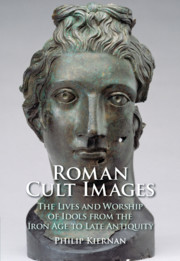Book contents
Two - The Birth of Cult Images
Early Rome and the Iron Age
Published online by Cambridge University Press: 15 May 2020
Summary
Roman historians often claimed that their ancestors did not have images of the gods, but a closer look at both the archaeological and textual evidence suggests that images of the gods were venerated at Rome at a very early date. Similarly, both ancient and modern writers have claimed that Iron Age European religion was entirely aniconic. This chapter surveys Iron Age statues in stone, metal, and wood to provide evidence that the gods were worshipped in the form of images prior to the Roman conquest. The stone images include important and recent finds from the Glauberg and Vix, a large series of buste-socles from Paule, Nîmes, and elsewhere, while metal representations include statues from Bouray and St. Maur. Surviving wooden images, including those known as Holzidole from northern Europe, finds from Pforzheim, Villeneuve, and Yverdon-les-Bains, all suggest that wood was a common medium for depicting the gods in the Iron Age. These early images possessed a degree of iconographic variety that allowed the divinity represented to be identified. More importantly, the context of these artworks confirms that they were the focus of ritual, the recipients of offerings and sacrifices, and not just funerary markers or representations of local aristocrats.
Keywords
- Type
- Chapter
- Information
- Roman Cult ImagesThe Lives and Worship of Idols from the Iron Age to Late Antiquity, pp. 24 - 84Publisher: Cambridge University PressPrint publication year: 2020



